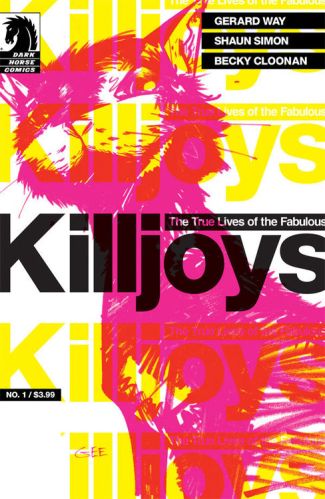Category Archives: True Lives of the Fabulous Killjoys
The True Lives Of The Fabulous Killjoys: CHAPTER 4 >>> RUN!
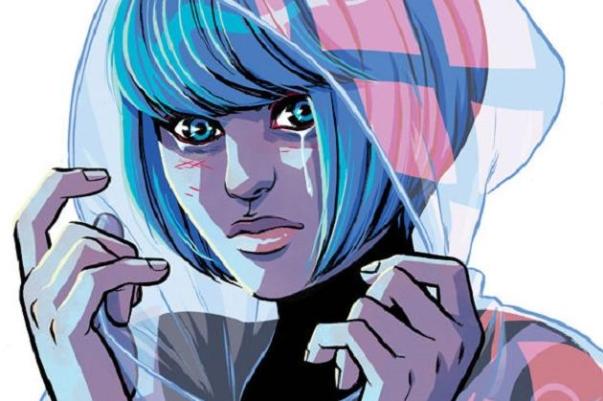
There’s sense of Déjà vu that occurs toward the end of the chapter that sends shivers down your spine. As the radio plays and the night moves along, you suddenly hear a familiar voice, one much unexpected. Perhaps, over time, you may have forgotten it or perhaps the bombastic voice of anarchy and youthful rebellion had been forever ingrained in your head. Either way, this is the moment you know that Killjoys is more than just a flash-in-the-pan series, but a decade spanning project of love.
The True Lives of the Fabulous Killjoys>>> Chapter 4: Run! certainly lives up to its title. With the BL/Ind breathing down everyone’s necks, all the key players make a mad dash towards their own hopes, dreams, nightmares and fears. With Red and Blue trying to escape Battery City, The Girl trying to escape her past and Krause trying to escape his employers, things certainly escalate quickly for our motley crew of freedom fighters. What follows is a heart-wrenching, nail biting and shocking issue that is without a doubt the highlight of this already excellent series.
It’s not every day that I am compelled to re-read an issue the second I finish it, I tend to let it digest first. However as of this review, I have re-read this issue four times now and each time I find myself lost in wonder and cringing with unease. As we head towards the dénouement, Way & Simon has made sure all that hard work and fan favouritism has paid off. This chapter is the reason I told you to bone up on your Danger Days! and those of you who did will have undoubtedly received the same goose bumps I have. This is a shining example of how to plot a series.
Cloonan & Jackson’s homage to the 80’s punk films of yesteryear continue to be the cherry on top of a very decadent sundae. Just check out that splash page featuring Red & Blue, it’s a marvel to behold. It seems that Cloonan has found a perfect match with Jackson and his vibrant colour scheme. Their loose and cartoony style really helps to juxtapose the darker elements of the issue, and man, does it get dark.
With the finish line in sight, The True Lives of the Fabulous Killjoys>>> Chapter 4: Run! is revving it’s engine and firing on all cylinders. I’m not too keen on perfect scores, but I was hard pressed to find a reason against awarding one. Killjoys, you are perfect, now make some noise!
The True Lives of the Fabulous Killjoys>>> Chapter 4: Run!
Script / Gerard Way & Shaun Simon
Art / Becky Cloonan
Colours / Dan Jackson
Letters / Nate Peikos
Cover(s) / Becky Cloonan & Gabriel Ba
Publisher / Mike Richardson for Dark Horse Comics
Click at pictures!
The True Lives Of The Fabulous Killjoys #5 (Gabriel Ba Variant Cover)

“To put it as clearly as possible . . . there is something wrong with you and we are going to fix it.”
Better Living Industries works to reeducate Korse and is met with deadly consequences just as the Girl learns lessons from her forgotten past. The big battle is brewing in the sands of the desert as the Killjoys march on Battery City!
* From Gerard Way, creator of The Umbrella Academy!
* One of Wired magazine’s and IGN’s Most Anticipated Comics of 2013!
“Buy into the hype. Killjoys . . . is killin’ it.”—Newsarama
CREATORS
- Writer: Gerard Way, Shaun Simon
- Artist: Becky Cloonan
- Colorist: Dan Jackson
- Cover Artist: Gabriel Bá
- Publication Date: October 09, 2013
An exclusive conversation with Gerard Way, Becky Cloonan & Shaun Simon, Part Two
Part two of an interview with Gerard Way and Killjoys collaborators Shaun Simon and Becky Cloonan about life, the future and the past.
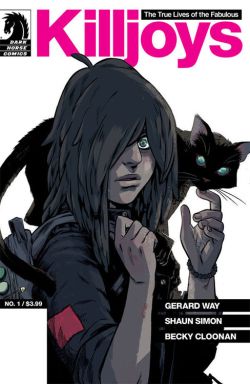 As issue two of The True Lives Of The Fabulous Killjoys is released, we thought it was time to catch up with author and My Chemical Romance frontman Gerard Way, as well as writer Shaun Simon and artist Becky Cloonan. To read the first part of this interview, click here
As issue two of The True Lives Of The Fabulous Killjoys is released, we thought it was time to catch up with author and My Chemical Romance frontman Gerard Way, as well as writer Shaun Simon and artist Becky Cloonan. To read the first part of this interview, click here
This is part of a series of articles published to celebrate the ongoing Killjoys series, with the main interview in this month’s issue of Rock Sound.
How do you feel about fans approaching this as an extention of the band?
Gerard: “Shaun was there at the beginning. He had a band [Pencey Prep, which also featured MCR guitarist Frank Iero] before we had a band. He watched My Chem get born and watched one of his best friends join, then he got into the band with us, but we had no money to pay him but we were all drifters back then. He’s part of that story. For Becky, she was there during the MCA years and before that, and we’re all connected to music in a weird way.”
When you look at the world as a whole, what are your gut reactions?
Gerard: “There’s a lot of hate, homophobia and discrimination, but I always look at the world as a pretty incredible place filled with courage, art and integrity, and sometimes it goes unpronounced. You can be a part of that, you can make it happen. It’s not about getting the credit for that, it’s about having valour and doing the right thing. The world at large is beautiful and incredible, and I started to view the bad stuff as chaos. You’re not going to have a beautiful place full of many different components, like the human race, without chaos and people acting out within that chaos. That’s where I think all the bad comes from; byproducts of our chaotic nature as human beings. We can’t really help that. You’re either on one side or the other. But my world is pretty positive.”
Shaun: “The world – everything is there, it’s just what you pull out of it yourself. There is a lot of great stuff out there, you’ve just got to find it. But I would like the option to have a rock station in New York instead of one continuous chain of crap.”
Becky: “Sometimes I get into the habit of thinking things were better a few years ago, or 10 years ago or 100 years ago. The music or the writing was really cool, but thinking of now, with all the changes happening, it’s the best time. The internet is changing everything. I can’t imagine growing up now and having all of that at my fingertips. It takes the adventure out of finding new things, but on the other hand I wish I had access to all this growing up. But I don’t know how much of that would’ve affected me, because so much of who I am was built on being 14 and trying to figure out who I want to be.”
Gerard: “It’s been a long time since I’ve woken up and I can’t wait to play guitar while being a mentally present father. Towards the end of MCR I was just… there… and when I reconcile that with myself you can’t make up for lost time but you can make the time you have great. One thing I’m thankful for is that I figured out some stuff pretty early. Was I ready to be a dad? No, but I’m great at it. You can’t be two people in your brain, one rock dude and a dad – there’s something in the middle of them, and that’s really what you are and that’s going to make you the best dad, not when you try to be one or the other. I’m still sleeping four hours a night and still grabbing instruments. The abstractions are pouring out of me and they’re making more sense than trying to craft them into a meaning.”
To read more pick up Rock Sound Issue 177 now, for more on The True Lives Of The Fabulous Killjoys head to darkhorse.com.

Red the first part of the interview with Gerard Way, Becky Cloonan & Shaun Simon
ViaPREVIEW: The True Lives Of The Fabulous Killjoys #3
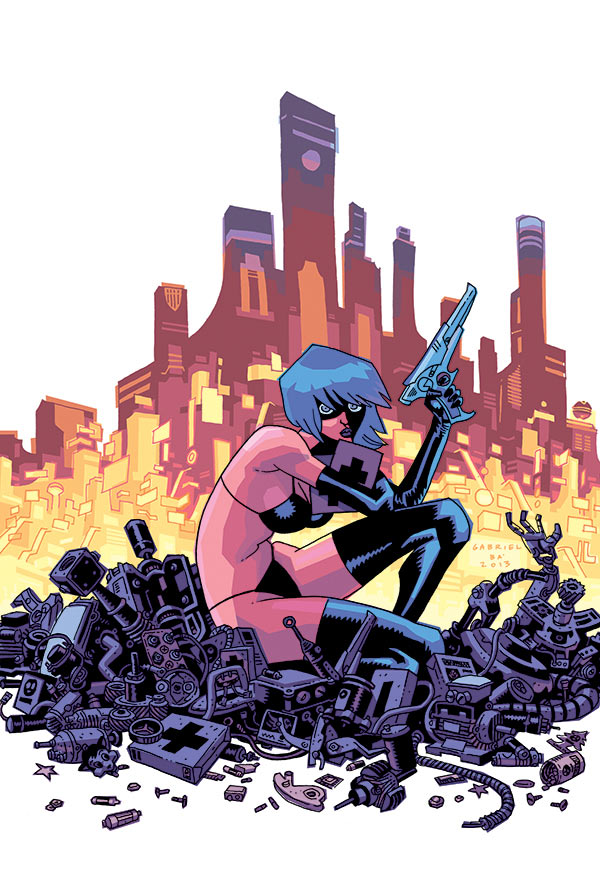
- STORY BY: Gerard Way, Shaun Simon
- ART BY: Becky Cloonan
- COVER BY: Becky Cloonan, Dan Jackson, Gabriel Ba
- PUBLISHER: Dark Horse Comics
- COVER PRICE: $3.99
- RELEASE DATE: Wed, August 14th, 2013
“The pulse is beating like a cheetah on speed!” – No longer content to hide from the prying eyes and lies of BLI, the Girl tries her hand at learning how to fire a ray gun with the help of a former Killjoy, Cherri Cola. But when her vision bends and her mind opens, will the Girl see beyond sight and view more than she can handle? How far can you see when you lose focus?
• From the creator of The Umbrella Academy!
• Art by 2013 Eisner nominee Becky Cloonan!
viaAn exclusive conversation with Gerard Way & Becky Cloonan & Shaun Simon, Part 1
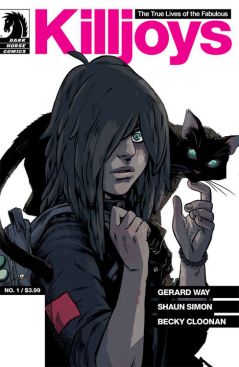
As issue two of The True Lives Of The Fabulous Killjoys is released, we thought it was time to catch up with author and My Chemical Romance frontman Gerard Way, as well as writer Shaun Simon and artist Becky Cloonan. This is part of a series of articles published to celebrate the ongoing Killjoys series, with the main interview in this month’s issue of Rock Sound, and the second part of this feature landing online on July 31.
Where does this release fit into the My Chemical Romance timeline?
Gerard: “The end of My Chem was the end. This was always intended to come out, maybe not the way it was originally written, but that’s just the case with everything. This is exactly what it was supposed to be. Anything in there that is relevant to the birth or ending of anything is not intentional. It’s the beginning of an awesome comic book career for Shaun, for Becky it’ll be a continuation of an awesome career. For me, it’s gonna be me stepping away from comics. So it’s beginnings and endings in a lot of ways.”
A lot of the story concerns teenage rebellion – Gerard and Shaun, as parents, are you prepared for your children to rebel no matter how good you are as fathers?
Gerard: “For fatherhood, there is nothing that can prepare you for it. Something that was very interesting during the record and even the life cycle of the band, was noticing the slight rebellion from the audience. A lot of these fans had grown up with us, so I watched them rebel against the world at large, and even against us in some way, and that was the point. None of that ever bothered me, because it made sense for them to rebel against us. Let’s say your enemy is boredom, corporate rock and people who don’t want to challenge things – you run the risk of becoming the enemy that you’ve taught everyone else to fight against. I’d be lying if I said I didn’t feel a little bit of that at times, but I think that is healthy and normal and you shouldn’t read into that in a negative way. I think it’s a fact of life that you become the very thing [you’re fighting], no matter what. Money and fame and all the things that make you what you are, and even if you try your hardest to hate that, you’re still going to possess some of those abilities and you are going to become a little less relatable. I felt a lot of teenage rebellion post and during ‘The Black Parade’.”

And you put a lot of that in the comic…
Shaun: “I think so. I’m worried about my kid growing up and not knowing what rock ‘n’ roll is. I’m in New Jersey and there is no rock [radio] station in New York anymore. Everything nowadays is so disposable, and it’s like listening to the same beat over and over again. I think a lot of that goes into this book. Teenage rebellion is a lot about diversity and another way of thinking, even what’s going on today in society. That’s what scares me.”
Becky, what was it like when you saw how extensively the spider had been used?
Becky: “Mind-blowing. Being involved from such an early point, from seeing the videos get made and hearing the album, it’s definitely made the comic as it is now. It’s perfected my art. I have so much more to draw on now; the videos have influenced the comic, or lyrics have made it in to the final incarnation of the comic. There are so many fans who make their own Killjoys costumes, and I think ‘That’s a cool mask, I’ll take that idea.’ There are so many people collaborating in a weird way.”
Shaun, what were you doing between being in a band and now?
Shaun: “I settled down, got married, had kids and became a barber. I’d always wanted to break into comics, though.”
Gerard: “One of the things he was doing was discovering comics – and I love the fact he discovered them late in life. There’s strength to that. He was only reading the good shit in a really dedicated way. I remember going over to his house after he had got married and his shelf was lined with the best books. He was passionate about it, his views were abstract and I felt like I really wanted to be a part of this next wave that he was a part of. Becky was the same type of artist. She’s in the small, awesome category where she is in a class of herself.”
For the second part of this conversation come back to the Rock Sound website next Wednesday, July 31. To read more about The True Lives Of The Fabulous Killjoys head to darkhorse.com.

Preview: The True Lives Of The Fabulous Killjoys #2
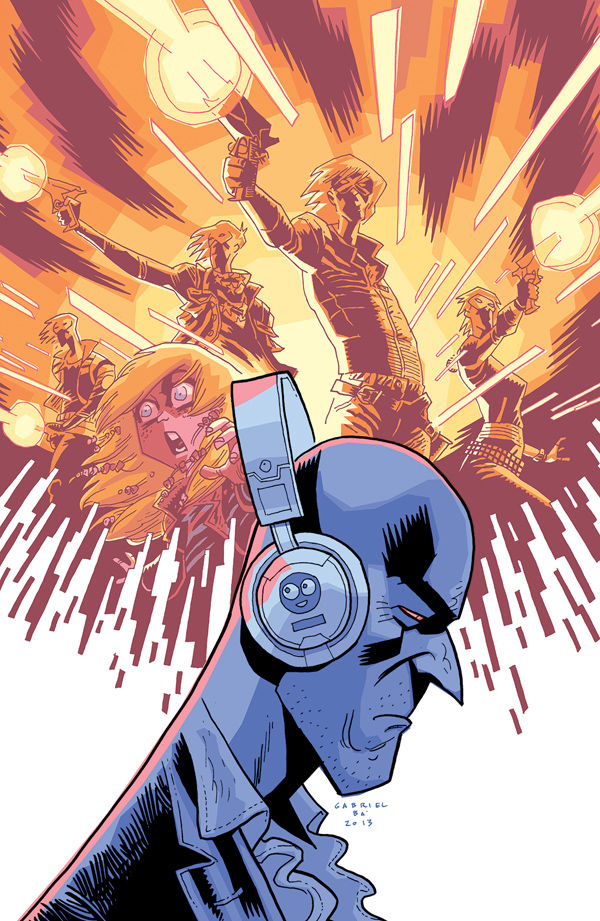
STORY BY: Gerard Way, Shaun Simon
ART BY: Becky Cloonan
COLORS BY: Dan Jackson
COVER BY: Gabriel Ba, Becky Cloonan
PUBLISHER: Dark Horse Comics
COVER PRICE: $3.99
RELEASE DATE: Wed, July 10th, 2013
“Our home was sent to the heavens and there ain’t nowhere to go!”
Delve into the life of Korse, one of Better Living Industries’ most productive and violent Scarecrows! See the trials and tribulations faced by Blue, an android down on her luck! Meanwhile, find out who—or what—survived the original Killjoys’ deadly confrontation in Battery City.
Click at pictures
Commentary Track: Way, Simon & Cloonan on “KILLJOYS” #1

The band My Chemical Romance may have went their separate ways this year, but the colorful characters inhabited by the cutting edge punk quartet are living on in the form of “The True Lives of the Fabulous Killjoys” comic from Dark Horse spearheaded by singer Gerard Way.
In the works since the band’s 2010 album “Danger Days,” the series co-written by Way and Shaun Simon and drawn by Becky Cloonan expands the world of the rebel Killjoys characters who protected the life of a young girl fated to save a dystopian society in My Chemical Romance’s last set of videos. The comics story picks things up years later after the Killjoys have vanished and the evil Better Living Industries tracks the girl and her new Killjoys-inspired friends through a post-industrial desert wasteland.
With the first issue of the series finally on the stands, CBR News spoke to Way, Simon and Cloonan about their collaboration with a behind-the scenes commentary track on the big moments from #1. Below, the trio explain how ever good idea they had went into the comic, why the focus for the series and the band was on the fans of the Killjoys, what Grant Morrison brought to the table in playing Draculoid master Korse and more.
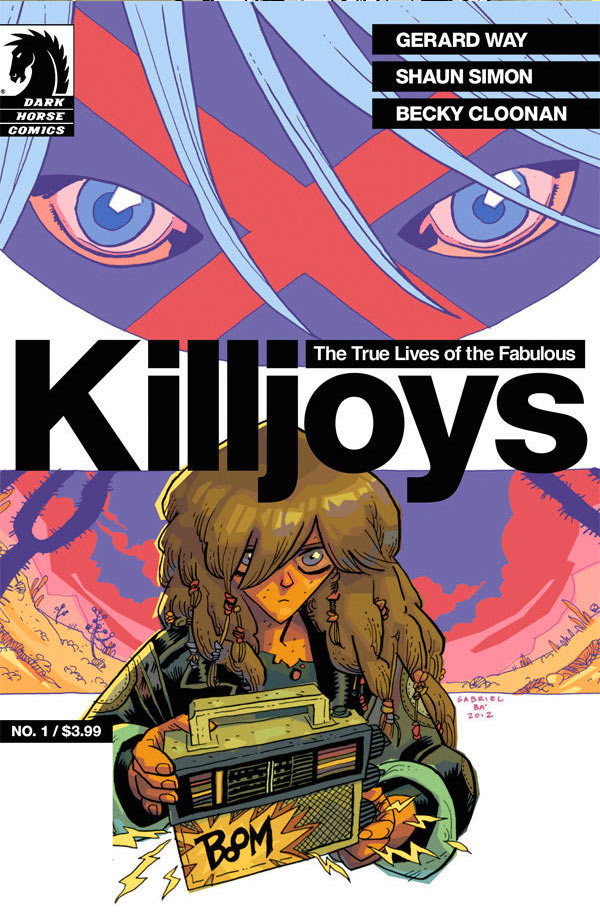
CBR News: Guys, “Killjoys” #1 has been a long time in the coming. What’s it like in general to finally have the story out there and in front of people?
Gerard Way: It’s super crazy. It’s been so long!
Becky Cloonan: On the day of release, I was just inundated. I had to turn my phone off because it was just constantly vibrating. It’s gotten to the point where I can’t keep up with my Twitter feed because of all the replies. [Laughs] Every once in a while I look in on it, but it’s just crazy.
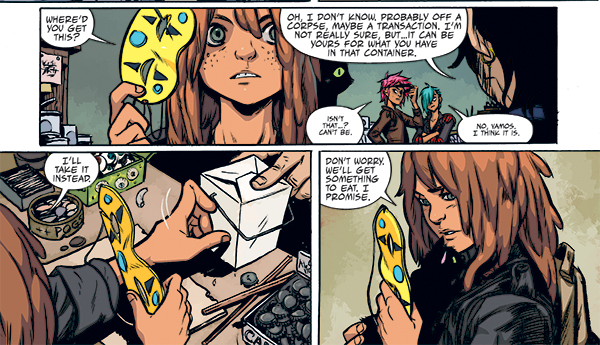
The thing I found most striking about this story was that it was not only set after the story of the album, but it’s focus is on fans. Many of the characters here are obsessed with the original Killjoys and are building their own culture from that idea. Why make that specific focus?
Way: I guess it’s two things. This story has changes so much, but when Shaun and I decided to go the path we chose – and even from my standpoint doing the videos – this was always the girl’s story. I never felt it was the band’s story. I know that sounds kind of strange since the band is very relevant to what we’re doing, but even in terms of our band’s whole career, I always felt it was the fans’ story – their experience with My Chemical Romance.
And in the comic, the stuff with the Ultra V’s I think Shaun and I handled in a really cool, mature way. It was drawn from real life. Are they fans, or are they different? I think they’re more realistic. I think they’re people who at one point looked up to those guys and then kind of grew out of it. They said, “We can do it better” because the next generation is always trying to eat the old one.
The story opens with and is framed by this DJ telling that story. I know that’s the same way the album worked, though I keep thinking of movies where this happened – “The Warriors” or “American Graffitti.” But is there a specific inspiration that led to that framing device to drive the narrative?
Way: “Vanishing Point!” For me, that movie was the early one we looked at. The DJ in “Vanishing Point” is the unsung DJ of ’70s movies. [Laughs] When it was just a guy named Mike Milligan going on this odyssey with his radio talking to him – which was one of the original incarnations of this – we were very much paying attention to “Vanishing Point.”
Shaun Simon: I think that’s what started it, and then after the record, Gerard had built this whole world around the Killjoys. When it came time for the comic, Gerard called me up and said, “We ran out of money. We wanted to make the third video, but we don’t have the money. So do you want to make the idea for that video into a comic?” We started talking about ideas, and we had so many that it turned into this whole series.
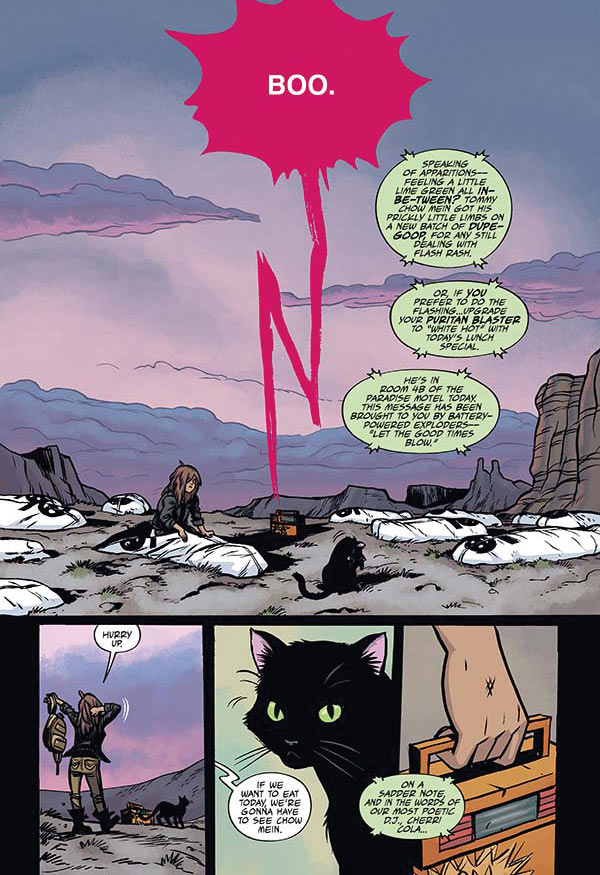
And it seems like the comic was born out of a lot of collaboration. Maybe this is just me, but I feel like Becky added the cat in. Or at least I want to see Becky draw cats forever now.
Cloonan: No, that was in the scripts. [Laughs] But going back to what you were saying about the fans and everything, this project has been going on for so long it’s like the comic was informing the music which was informing the videos which informed the comics. You get all these fans that are invested in this story and this world that it’s really been what I try to keep in my mind as I draw it. This is a world people already know about and have thought about. That makes me extra conscious to be as true to that as possible. I’ve got these spreads where I watched the videos and said, “Oh, that’s in the background. Let me put it in this background.” It’s something I’m constantly thinking about.
There was a template set by the videos for a lot of the scenery and costuming, but what were the elements that you guys found were the most unique to comics?
Simon: The Lobby and Battery City. That was a whole part of the story that just didn’t exist in the videos. It’s brand new to the comics, and even in the world that was there, we were expanding on that too. With The Nest and these other parts of the desert and these other characters, the whole world continues.
Cloonan: It’s like every timeline in this could shoot off into its own new comic. There’s so much world building. It’s so great and so lush.
Way: What was really fun for me, because I did so much of the design work for the videos, was that there were a lot of discussions happening over that time. Shaun, Becky and I would talk frequently, and what was really awesome was how all the stuff came together that wasn’t in the videos.
At one point, I was talking to Shaun, and I said, “It’d be really rad to shoot this extra footage of you as the fifth Killjoy.” And the stuff Shaun came up with for the Ultra V’s had a really distinct vision. I’d had a vision for this Kill team, and then to see Shaun’s vision of this young Kill team and Becky’s vision that she threw into the mix, it mean we all got to design them. It was really amazing. Especially with Cola, I felt like Shaun in a lot of ways would have been Cola [in the videos] if we’d had more money.
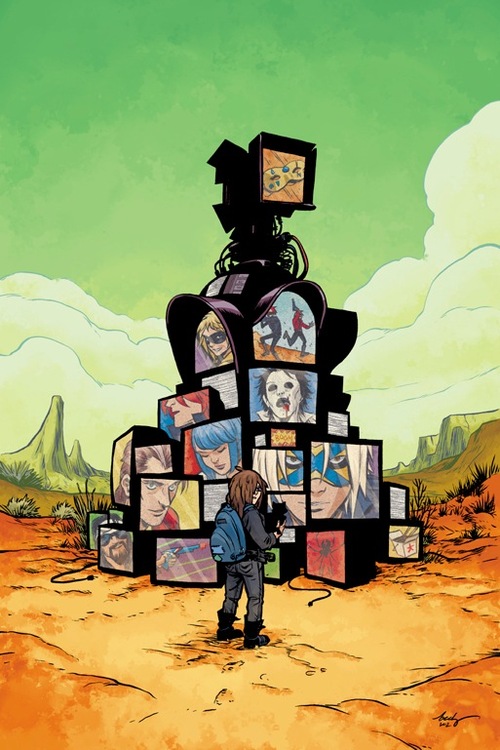
Let’s talk a little bit about each of the main threads introduced in this issue, starting with the girl herself. The videos took place years before the comic, when the girl was still young, and the original Killjoys were convinced she was fated to save the world. What’s the attraction to centering this story on a “chosen one” arc?
Way: Shaun and I talked a lot about how in this story, we have all the trappings of dystopian science fiction. And I learned long ago that you can use these built-in scenarios so you can just pop things in the story and not spend a lot of time on that. People automatically look at it, and it’s a visual clue that this is a dystopian situation like “Logan’s Run” or stuff you maybe saw on TV growing up. Having that built in already, it allowed us to put more in under the surface. One thing I keep saying in interviews is that I hope people are going to be able to take a lot more from this than from a simple dystopian story. It’s really not just that. We’re able to subvert and try different things. There’s a very human story in here as opposed to a classic “Man Vs. Society” kind of thing.
Simon: One of the things we decided early on was that you open on page one, and by page two and three, you’re off already. We didn’t want to spend time explaining everything. No long exposition. We just wanted to get up and go. Like Gerard was saying, in these types of stories you automatically get it. We don’t have to explain how the world got here and why it’s like this. We just go. I always say that I like to figure things out as I go. I don’t want to be told everything at the beginning. I want things to be a little mysterious so I can take the journey along with these characters and find out things as they do.
Cloonan: And each character has their own journey. For the girl, for me, it’s very much her coming of age story. With some other characters, I can approach it as more of a romance. And with another, it’s about trying to find himself while keeping part of himself hidden. It’s about him coming to terms with it and being okay with himself. This all comes under the veil of this science fiction/dystopian future/Orwell scenario, but it’s grounded in these very human elements. I try to keep that in mind as I layout each page.
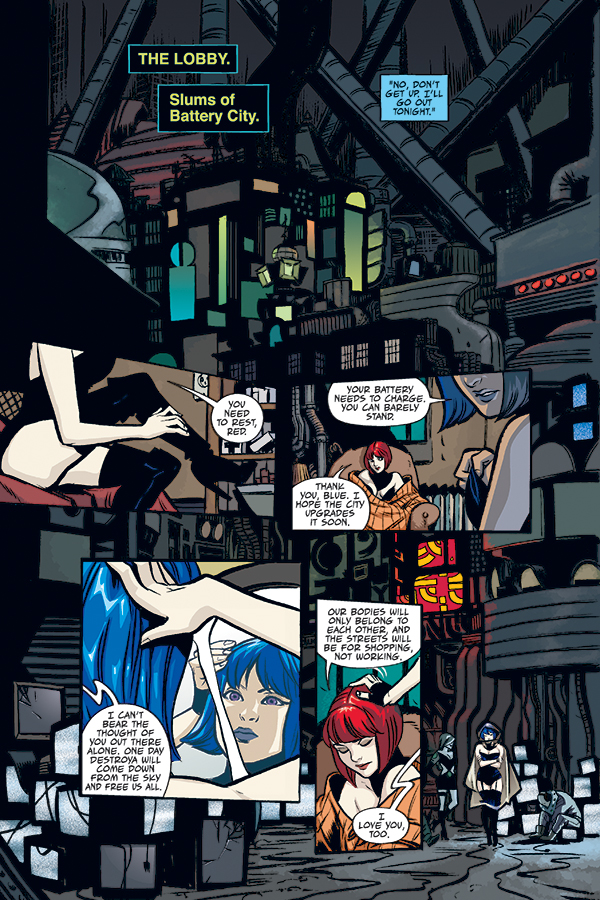
One of the newest elements to the comic, like you guys were saying, is Battery City and the Lobby. And the key figure in that story seems to be Blue. She’s one of the few people in this world we’ve seen who’s been on the inside of all this, but so far we know so little about her. What’s her story all about as the book goes along?
Way: There’s a cool real life backstory to how Red and Blue both ended up in this story.
Simon: When we were working on “Killjoys,” I had this idea for a project called “Black Market Women” which was about these two sex workers who lived in the Lobby. As we started talking about the comic, we realized that what we were talking about for both was the same kind of stuff. It was a lot of extending the world and things we wanted to explore more. And this story really became about how Better Living Industries is affecting not just the lives of the people in the desert but also the lives of people in the city and people who work for the corporation. In issue #2, there will be another main character added to this story, and we’ll get to know his story too. It’s all about how the corporation is affecting these people in very similar ways.

Was there one new thread in all of this that became more important or most important to each of you as the full extent of the world took shape in the comic?
Way: I feel this is a very unique book in that we became excited about all the arcs, but then as we got going more arcs became present. Like Phoenix Witch came into it and grew into something way more important than just a side character. At one point, Shaun had a breakthrough on what Phoenix Witch was. Some of the springboard stuff literally came from standing in the desert with your friends and going, “Hey, this is going to look really cool.” We’d shoot it in a really bad hotel room with a dead guy on the bed, and Korse is grabbing my face and yelling in it. We had no idea what was happening in that scene. It just looked like a cool shot. A lot of those images ended up informing real stories. Phoenix Witch was like that, but it was something we didn’t get to put in the videos because that was a really expensive costume to make.
Having said all that, all the arcs became thrilling to us. We’d discover something about Korse and have to do that. And other characters would find something important out about themselves, and we’d have to work it in.
Simon: I think what it comes down to is that we had so many ideas and characters, and the ones that really stuck out were the ones we cared about in the comic. That’s what we ended up including in there. For example, in the Free Comic Book Day story we had Vacation Adventure Society, which is something Gerard and I have been talking about for probably ten years now.
Way: Oh my God! [Laughs] That was totally insane.
Simon: I know, right? It was so cool that we finally got to do that, but it really could have been a whole story all on its own. We only did the ones that really meant something to us.
Way: Yeah, Vacation Adventure Society was an idea that Shaun and I had to start a band that was basically a DAT machine. Shaun was going to dress like a guy who worked a booth at the Jersey Shore way back in the day, and I was going to wear a gorilla suit. That was the thing! It was going to be like party electro punk.
Simon: Some of the earliest shots of it were just of a keytar on the Jersey Shore for the cover of the record. [Laughs]
Way: What I love about this comic is that for this whole world and all the creators, no one was stingy about any ideas we’d come up with in our entire lives. Even if it was an idea we loved that could only show itself in a Free Comic Book Day special or just half a panel, we’d just throw these ideas in there. It adds to the world.
Cloonan: I hate the idea of saving ideas anyway. It’s like saying, “I have to save this for later because it can only be good later.” If you’re thinking like that, you only save ideas. If you use the ideas now, you have to think of something better later.
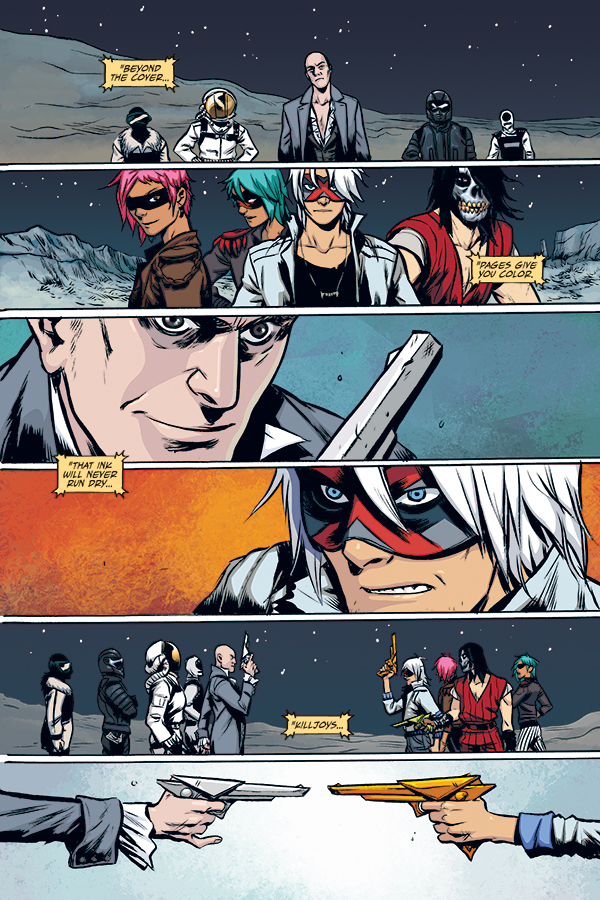
Lastly on the tour of the book are the Draculoids and Korse and all the villains from the video, and it seems so far like we’re going to get a lot more story on how these drones for the corporation came to be. You’ve said you had so much fun doing the designs of the Killjoys and the Ultra Vs who are so much their own people. Is there something fun about doing these characters who are forced to be more uniform?
Way: Yeah. That was actually, in a lot of ways, more fun because it was a really big challenge. And I didn’t even realize this until we were filming the second video, but Jimmy from the band Mindless Self Indulgence played the main Draculoid, and he came up going, “I just realized…me and the other guys kind of look like Stormtroopers from Star Wars, but we’re these really insane punk rock ’70s horror movie versions!”
And Becky also pointed out, because she was the first person who had to draw them, that they look like Sid Vicious. She said, “I’m drawing this crazy Sid Vicious vampire” and you had this other reference point too…
Cloonan: It was Michael Myers from “Halloween!” These are like if Michael Myers were running around in a vampire cape. [Laughter] That’s how I approached it.
Way: So they were really fun to make. You’re getting into this world and just having fun with it. Again, you can just make something that’s not super generic because you’re not riffing on World War II stuff for your villains. You can have so much fun with it. Sitting with Grant [Morrison] was insane. Grant really designed his own costume. I sat down with him and said, “Let’s talk about Korse” and he immediately said, “This is what I think abotu Korse. He’s a bit of a dandy.” And he’s got all these ideas for it.
Cloonan:I love that Grant Morrison just owns that jacket. [Laughs]
Way: He was like, “I really want a frilly cuff.”
Simon: One of the best panels Becky did in issue #1 was when Korse was holding the gun. It’s so him.
Way: We practiced that a lot. I remember standing in my house and handing Grant his gun, and he immediately held it up in front of his face and was just like, “This is how Korse would hold it.” [Laughter] It’s crazy how many memories are coming back now that the book is coming out.
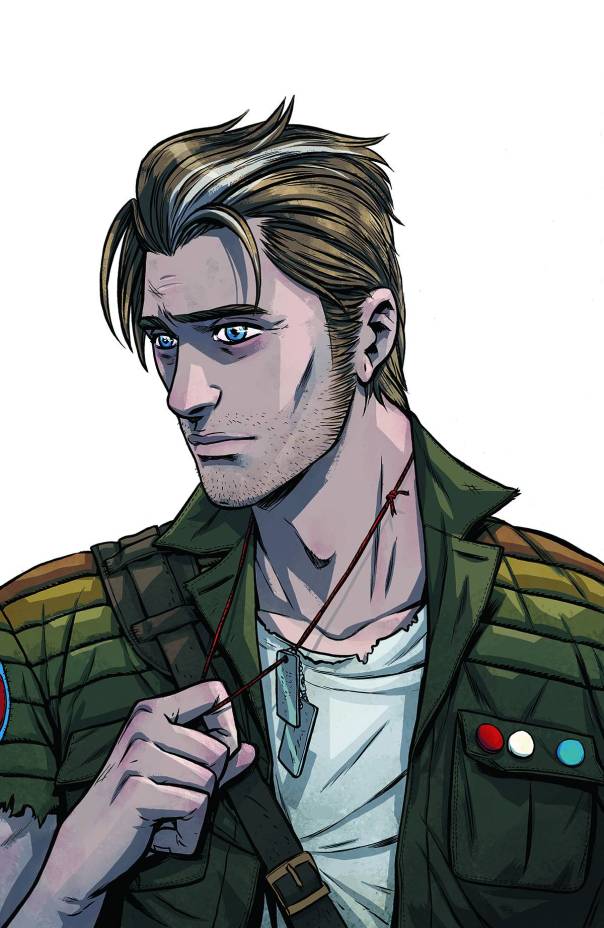
Looking forward, we’ve had so much of the ideas started up already, but there’s still a lot to do yet, and you left this on a literally explosive cliffhanger. What comes next?
Way: It’s a super dense story, and Shaun and I thought we were going to have to add an extra issue.
Simon: We already have the girl, we have Red and Blue, and in issue #2 we’re going to introduce our third main character. He’s in issue #1 some already. But it’s three main characters, and the thing about #1 is that if you really pay attention to it, when you get to the final issue you’ll see that there were some elements of it set up from the very beginning. Everything that happens here has a purpose and a reason, and everything’s going to be explained. Every thread will close, and you’ll have no questions left. The book goes up and down, but it’s moving the whole time.
Via
The True Lives of the Fabulous Killjoys #4 (Becky Cloonan cover)
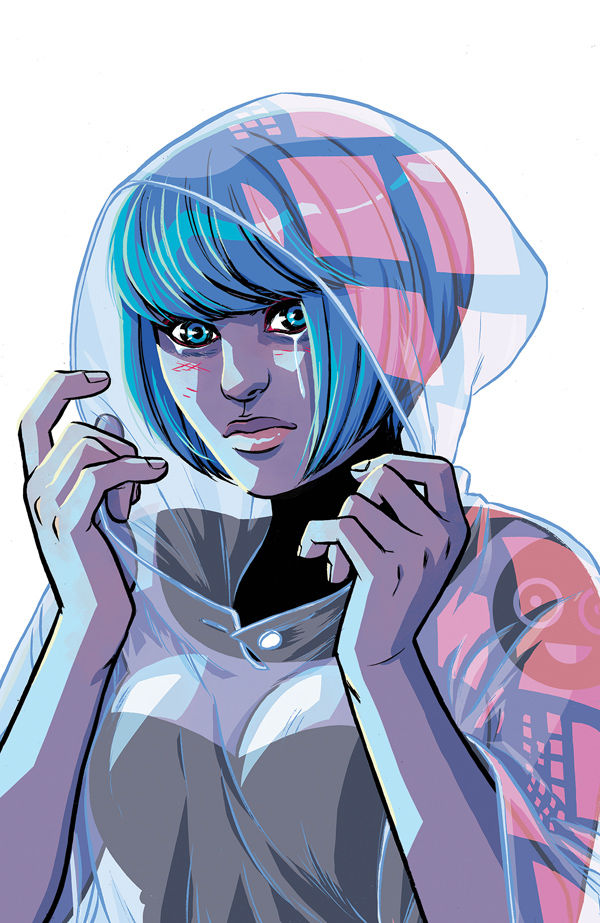
“Love. It makes people do dangerous things . . . It’s an emotion better suited for the uncivilized class.”
Wanted fugitives Blue and Red, porno droids that have disobeyed the strict rules of Battery City in the name of love, make a run toward freedom. Will they make it to the city line before BLI pulls their batteries? In the desert, the Girl makes a life-changing discovery and suffers the loss of a dear friend. The party’s over and it’s time to fight!
* From Gerard Way, creator of The Umbrella Academy!
CREATORS
- Writer: Gerard Way, Shaun Simon
- Artist: Becky Cloonan
- Colorist: Dan Jackson
- Cover Artist: Becky Cloonan
Killjoys launch with Gerard Way & Becky Cloonan @Beach Ball Comics
To celebrate the release of ‘The True Lives of the Fabulous Killjoys’, writer Gerard Way and artist Becky Cloonan visited Beach Ball Comics in Anaheim yesterday to meet fans. Despite a late start due to the crazy LA traffic, the crowd waited patiently and both Gerard and Becky ended up staying until well after midnight to make up for the delay and made sure everyone got their comics signed and pictures taken. We managed to get some shots at the signing table.
Click at photos
Via
Catching Up With The True Lives of the Fabulous Killjoys Writer Gerard Way [Full Interview]

As the former lead singer of glam punk heroes My Chemical Romance, Gerard Way knows how to tell a story. Concept albums Three Cheers for Sweet Revengeand The Black Parade unspooled bittersweet, goth-tinged tales of resurrected gunslingers and postmortem cavalcades into the band’s theatric thrash with style and substance. Way made the full transition to scripting with his 2007 Dark Horse comic The Umbrella Academy, the portrait of a dysfunctional family of superhero misfits searching for purpose while saving the world from mind-bending threats. A graduate of the School of Visual Arts in Manhattan and a former intern at DC’s Vertigo imprint, Way proved just as adept with a pen as a microphone, winning an Eisner Award in 2008 for Best Limited Series.
Today marks the debut of Way’s new series The True Lives of the Fabulous Killjoys, a heady descent into post-apocalyptic intrigue and grind house psychedelia that completes the story started in the 2010 MCR album Danger Days and its videos for singles “Na Na Na” and “Sing.” Along with co-writer Shaun Simon and artist Becky Cloonan, Way paints a conflicted world where a gang of teenage vagrants fights a totalitarian corporation and its legion of vampire-masked drones while a pair of android prostitutes shares a secret bond.
Over two interview phone sessions, Way chatted with Paste about his new comic’s connections to his past as a commercial recording artist and what inspired his aesthetic shift from white face paint to red hair dye. Way also digs deep into the underlying sociological issues at Killjoys’ heart and how Dora the Explorer, the Blade Runner documentary, and the Sega Master System influenced it.
Paste: Congratulations on your first issue of The Fabulous Lives of the Killjoys. This is a continuation of the story you started in your Danger Days album from My Chemical Romance. Did this plot emerge after you finished the album or was it a part of the story the whole time?
Gerard Way: The deal is that I had written three videos (“Na Na Na,” “Sing,” and “The Only Hope For Me Is You”), and the third video had never gotten made. By the time we had completed the second video, we just ran out of budget money. At the time, somebody was managing us and not keeping an eye on this stuff. Long story short, there was no budget. So I wrote a video, and of course it ends up being the most expensive one, as the last part would usually be. But we couldn’t make it!
Killjoys started its life as a very different comic. It was heavily-rooted in nineties Vertigo post-modernism. There’s a lot of very cool, abstract ideas in it; I wouldn’t even call it a superhero book. That (comic) was a visual and thematic inspiration on what would become the album Danger Days. It was pretty loose, though. This was going to be my interpretation of the story, so there’s way more science fiction involved. And what I need to say to the world needed to be a little more direct, so I boiled it down to something that’s still very smart and challenging, but I thought was definitely easier to understand through song or visual.
Then (Killjoys artist) Becky Cloonan drew a 7-inch for “The Only Hope For Me Is You,” which was going to be the last video single. I realized I was out of budget, so I said ‘just make this the girl from the first and second video at 15. And have her shave her head or chop her hair off like in The Legend of Billie Jean, because that’s how the video was supposed to start.’ So (Cloonan) sends this drawing over and I’m on tour with Blink 182 in a hotel on an off day. I get this drawing and I’m so immediately blown away by it. I call Shaun, my co-writer and co-creator, and I say ‘open your email, I’m going to send you something.’ I ask him ‘how does this image make you feel?’ We talked for two hours. By the end of the conversation we both realized that that image was the comic, and the third video was basically the comic. So we figured how we were going to make this interesting and exciting for six issues and complete the story. And that was the final direction. It was pretty obvious to us.
And I like the fact that the story was about The Girl. It’s basically about somebody who was selected for this higher purpose who simply didn’t want to do it.
Paste: This story arc dates back to around 2009, which is when your daughter, Bandit, was born. Does Bandit inform the character of The Girl at all?
Way: (Co-writer) Shaun Simon was the first of our friends to have a child, and it was really crazy to even think of that. And then when (Way’s wife and Mindless Self Indulgence bassist) Lindsey and I had Bandit, I got it. And that’s when Killjoys really started to click. And I do see my daughter in her, because, for better or worse, she’s going to be her own person when she grows up. She’s going to be amazing, obviously, and have her own dreams. I just think there are going to be occasions where there’s this kind of weirdness based on what her parents used to do for a living. I think there’s an element of that even in the comic where The Girl used to hang out with these dudes who were shot, and people have different opinions of them. Some people like them, some people hate them. She has to deal with that. That’s the cool thing. You don’t get to see that stuff in comics.
Paste: One interesting element of the issue is the Draculoid masks, which force the wearer to experience an artificial perception of fear and victimization shared by all other Draculoids. It all feels vaguely political, reminding me of when Glenn Beck attacked your song “Sing” as propaganda after it appeared onGlee (there’s also a scene where the Draculoids complain about loud music). The main irony is that the masks came before Beck attacked you. Were you reacting to anything specifically when you first created the masks?
Way: (MCR guitarist) Frank Iero had that mask. It was just an aesthetic thing. ‘70s horror masks are pretty incredible. There’s something that’s really amazing about that era of painted rubber and hair. It kind of represents the past of the band. I liked the idea of them now becoming our enemies, just chasing us down or haunting us. All the Glenn Beck stuff, that came from a place of being in a rock band that started literally playing in basements. Even when we got big, it still felt like that same band playing in basements.
This isn’t even a jab at the record label, but when you have a large success like The Black Parade, the stakes really get high and a lot of people rely on your success, even magazines. You’re just part of this industry that feeds on a monetary exchange, which is fine — I’m not bagging that. So you’re expected to transform into this thing that’s a rock band. ’It’s cool that you’re like this, but now we just need you guys to be a rock band, and you need to become stable and we need to know what to expect from you.’ That kind of pressure can really mess with your art and really mess with your head.
So the whole Better Living Industries thing is about being part of the solution and part of the problem. Are the Killjoys the heroes? If you want to look at it in a nihilistic 15-year-old point of view, watching A Clockwork Orange for the first time, I guess you could see them as the heroes. Are Better Living Industries (BLI) really the bad guys? Who’s the bad guy? I feel like The Girl just wants to hang out with her cat.

Paste: So The Killjoys aren’t necessarily the heroes and Better Living Industries aren’t necessarily the villains; this comic is more grey. It reminds me of The My Chemical Romance song “Teenagers,” but these teenagers are a bit crazy and Clockwork Orange-ish.
Way: To bring it into A Clockwork Orange, I think I saw that when I was way too young. I had a couple of really cool friends when I was a kid, and we’d find cool music and movies and show them to each other. My friend Dennis had a copy of A Clockwork Orange and he’d already seen it once, and he was like ‘we need to watch this.’ I was sleeping over his house — and I think we were literally 15 — and we watched it. I remember my first reaction to that film was very similar to my reaction to Taxi Driver or my first reaction to Watchmen, where you just immediately gravitate toward Rorschach in Watchmen or Alex fromClockwork. And then you start to get older and realize that character wasn’t a hero at all; they’re really bad people who didn’t do anything heroic.
When you’re exposed to that as a youth, you misconstrue stuff. Sometimes you literally only take it on the surface, and you see any strong action that’s done with conviction as the right action, and you start to realize later on in life that just because you felt strongly about it, it doesn’t mean it was the right thing to do. And that’s one of my feelings that I tried to inject into The Killjoys, especially with the characters of The Ultra-Vs. (Shaun and I said) ’let’s literally make these characters 15-year-olds watching A Clockwork Orange, just pulling all the wrong shit from it.’
Paste: Are there any modern-day equivalents of Better Living Industries?
Way: In a lot of ways I feel that BLI wasn’t based on any specific corporation, it was just based on us. I felt that’s also what you could become: if you start off as a 15-year-old watching A Clockwork Orange and go to that extreme so young, you could become the person in the white office saying what’s right and wrong, saying what people should and shouldn’t do, making sure everything’s very clean. Those two types of people are literally the same person, they’re just at different extremes. I just based Better Living Industries on us as people. Whether we realize it or not, a large amount of us likes things to be organized, structured, clean, cleaned-up. That’s what we like, that’s what we go for.
Children’s programming for the most part, not all of it, is literally children coming out of some sort of camp or mill. And that’s not a hyper, aggro punk view on it, that’s just a fact. And so not only is that happening, but kids are responding to that. And parents are totally comfortable with the kids watching that. There’s nothing really wrong with that, but it says a lot about who we are. As free and crazy as we want to be, and how much we want to make the world a canvas, there’s also a part of us that doesn’t want to make any mark.
Paste: Did you notice this from watching what Bandit watches? How do you deal with this as a parent?
Way: I noticed it when I finally got to see a show like Yo Gabba Gabba!, and I realized there was such a high contrast in children’s programming between a show that people are taking a risk on and really trying as opposed to a show they know is just going to work. I didn’t realize at that point that there was such a high contrast in that kind of artistry. Flat out, Dora the Explorer…I don’t care if the people who made it are nice people, there is zero artistry that goes into that. There’s also, I believe, zero reference to the real world. I don’t even think images are Googled to have them correctly drawn. You’ve got that, then you’ve got Yo Gabba Gabba!. I know I’m friends with those dudes, but the reasons I became friends with them was because I admired their work. The people really try, so I notice that a lot. There’s a lot of bad stuff, there’s some good stuff. You just have to dig it out.
Paste: Talking about the general aesthetic of the comic and the Danger Days album, there’s a huge difference between the art direction of The Black Parade and Killjoys as both a comic and album, and it was mirrored sonically in the music as well. Was there anything that jumpstarted the bright, jarring color scheme and the garagey sound?
Way: As a musical starting point, (Danger Days) was protopunk and garage rock. So it started with The Stooges and then I put it through a science fiction lens. I went on this musical journey where, if this started with The Stooges, it ended with The Chemical Brothers. I remember listening to Exit Planet Dustwhen I was 14. That record, more than a lot of punk records, made me want to get up an run away from home. A lot of the digital came from that. I know EDM was happening at that time when we were making (the album), but it was still very underground. People weren’t winning Grammys for it yet, and it wasn’t on the radio. Right at that moment we were making Danger Days and we were a year and a half ahead of EDMexploding. The kids are getting their energy from machine-made things, not human beings playing through the same gear as the last band. That’s where that also came from sonically; I thought that was going to be the best idea to communicate.
Paste: You cast Grant Morrison as the villain Korse in your videos for “Na Na Na” and “Sing,” and he also survived into the comic. Some of the visuals remind me of The Invisibles as well. Did Morrison have a hand in the story at all?
Way: Well, he did and he didn’t. He did in the sense that to me and Shaun, (Morrison) was our biggest inspiration and our influence. It’s as if Shaun and I were in a band together and we loved Queen. We love ‘90s Vertigo. To us, if we had to pick a favorite from that (era), it would be The Invisibles. So in that way, Grant had a giant hand in it. There were also really cool collaborations that would happen when I was doing wardrobe designs and would sit with Grant. I’d already made his weapon at that point, so I handed him his gun and asked ‘how do you see this guy?’ or ’what’s in your subconscious that you want to come to the surface? Who is Korse?’ He immediately, because he’s Grant, had a vision for how he wanted to look. He said ‘I think he should be a bit of a dandy,’ which I had never thought of at that time. That made me think of Edward James Olmos’ character (Gaff) in Blade Runner. This guy’s a bit fancy, and he grooms himself very well. Grant even had all this crazy backstory for Korse that was really awesome. Spiritually and emotionally, artistically — more so in a guidance sense — (Morrison) was very, very hands-on with it.
Paste: I know you’ve cited Mad Max and The Warriors as influences, but I also saw some parallels to anime like Akira. Did that play a conscious hand?
Way: Absolutely. I was at a convention in New Jersey, and this was when conventions were still small; it was in a small area of a local hotel, like a Hilton. I walked past this TV, and this guy had a ton of VHSs, and I looked at this animation that was gorgeous. It wasn’t rotoscoped, and it also wasn’t like Voltron. I had read Akira as a comic, and had heard about them making it into a movie, but back then you got your news from the back of the issue you were reading. I knew exactly what that video was when I saw it, because one of the gang had just been beaten up by a Clown, so he was vomiting blood. I would never forget that shot. I bought it immediately. I spent all of my money on just that. I just went home with aVHS that I played every day. Constantly.
Having been a huge fan of the comic, too, there’s a lot I took from it. There’s a total reason the back of my jacket looks like Kaneda’s. But it was always important to me, even if I was reappropriating, to push myself design-wise to say, ‘well I like Kaneda’s pill, but how do I one-up it?’ That’s my challenge for the day. How do I make this different or a little more interesting? I turned it into this weird, graphic skull by adding crossbars under it to really make it a poisonous thing. Akira was huge. The Trans-Am to me is basically Kaneda’s bike. If I didn’t have red hair, I’m sure I would have been wearing red.
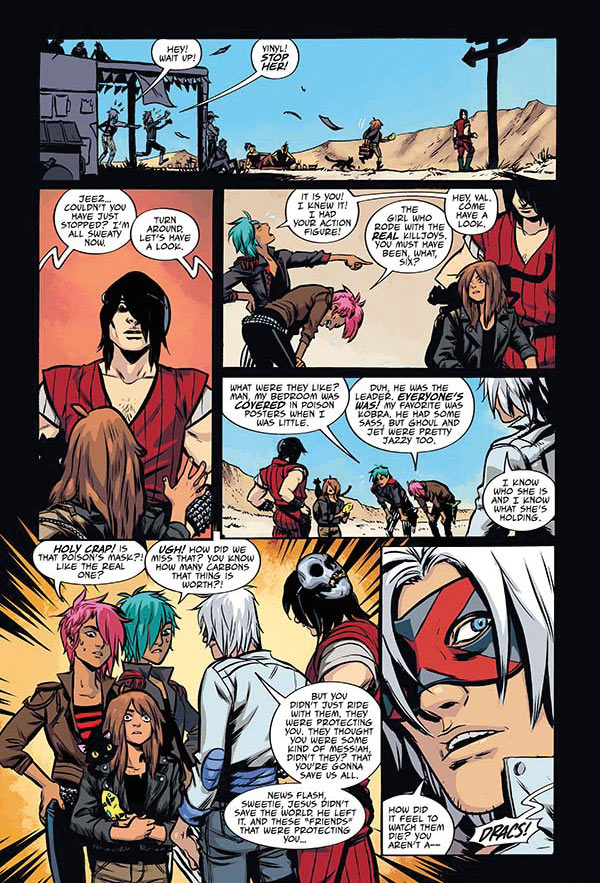
Paste: Did you ever play the videogame Jet Set Radio Future?
Way: In terms of having an influence on me, that came out a little late. But there was a game called Zillionthat was out for my Sega Master System, and that was a little impactful too, like Phantasy Star II for Genesis. There was some interesting stuff that threw its hat on the ring on this project.
Paste: What’s the most obscure or esoteric influence?
Way: There’s a film called Mr. Freedom by a French director who’s pretty bananas, literally about American superhero violence. Blade Runner wasn’t as much an influence as the documentary about the making of it. That had a bigger impact on the entire project. Watching the interviews, (director) Ridley Scott spoke about how challenging it was to get what he wanted, and how many problems it caused and how many bridges it burnt. Just what a struggle it was to have his vision seen through. I guess I really identified with that. There’s a quote from him where he references his camera as a weapon. I’d never heard a director do that and I started to see my art that way and see music that way. So that was actually the biggest influence, this documentary.
Paste: What do you want people to walk away with after reading this 6-issue miniseries?
Way: I think the main thing I want them to walk away with is a deeper understanding of the artistic process. I would love it if they walked way from it, despite it having some stereotypical trappings of science fiction and dystopian society, getting something new out of that. We’ve all gotten amazing things from Ray Bradbury and Logan’s Run. I just don’t think we’ve ever gotten the other side of that. We know that it’s bad to be a Sandman shooting people because they’ve turned 21; we don’t ever get to sympathize with why they do it. There’s a bit of sympathy for the devil in this, especially if people take away that we’re all kind of the devil in a weird way. We all have a hand in promoting safe culture. It’s easy to say ’he’s such a bad guy,’ but would I have done the same thing? There’s a lot more sentiment in this than there is in The Umbrella Academy and there’s also a lot more nostalgia. I just want them to get something different from science fiction in this.
Paste: You’ve also been tweeting some incredibly original Batman art from a 2008 pitch. Is there a reason for releasing it now?
Way: I guess it all comes back to that essay that I wrote when the band ended, where I intended to be completely obtuse and secretive when the band was existing, and when it stopped existing there was no need for secrets any more. So I started applying that to all aspects of my life. I was cleaning my office and I ran across what I felt were these really cool designs of Batman that I was proud of. I’m sitting there going ‘what if this never comes out? Why am I going to keep this in a box?’ I started to feel that way about a lot of stuff. What’s the worse that happens? Eventually the book gets made or it doesn’t get made because I released stuff. As it is now, I don’t have time to write it, so I don’t see that happening in the future. I stopped being so precious. I stopped being so greedy with my art. In a weird way, it’s this greed based in fear, and I have boxes of stuff that nobody’s ever seen that I keep to myself. Some of it I obviously should — not everything’s for sharing. I stopped being precious with everything, and I’m applying that to my life and the music that I make and the comics that I make. I don’t believe anymore in the hype machine or the strategy. I believe that you make something and then you share it. There’s no reason to wait.
Via





























































![Catching Up With The True Lives of the Fabulous Killjoys Writer Gerard Way [Full Interview] Catching Up With The True Lives of the Fabulous Killjoys Writer Gerard Way [Full Interview]](https://destroyanews.files.wordpress.com/2013/06/lll.jpg?w=90&h=70&crop=1)

